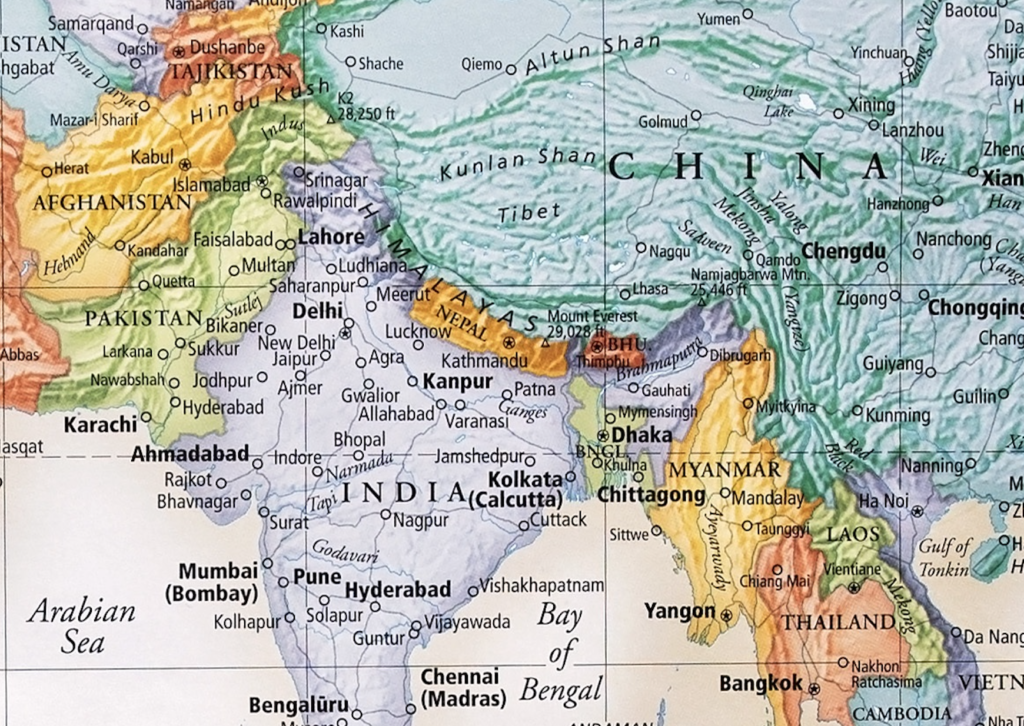
The remote and inhospitable Himalayas in the disputed State of Jammu and Kashmir (J&K) are in the limelight again and the reason is no different: the tensions between the countries controlling different parts of the contested territory. For a change, India and Pakistan are not the duo involved in the recent face-off, but China is flexing its muscle against another South Asian giant – India.
The reasons being offered for the Chinese advancements resulting into the face-offs range from acquiring tactical advantages to securing operational gains, but above all are the geo-strategic anxieties that China holds vis-a-vis India, and the underway muscle-flexing is an attempt to tranquillize those anxieties by conveying India a stern warning embedded in a polite message.
It is not contentious anymore that China – thanks to its grown stature and the USA’s abdication of the global leadership under President Trump – considers itself the most meritorious nominee for pre-eminence in Asia and plausibly, is a contender for global leadership. India, on the other hand, despite making remarkable economic surge during past two decades is no match to China’s economic, military and technological prowess, but it is the only country in Asia with a potential to challenge China’s dominance of the Asian landmass.
Although, it is another subject of debate whether India will be able to translate its latent potential into tangible national power or will fall prey to internal discord sown by the divisive Modi regime. Notwithstanding, the USA’s partial withdrawal from Asia, India’s geographic location as the most important littoral state of strategically important Indian Ocean and the country’s latent potential to emerge as a peer to China provide some justification for the empire-in-retreat the US to designate India as its offshore balancer in Asia.
To conjoin, are India’s the own global ambitions which sees this to be an opportunity to play a critical role in US’s Indo-Pacific Strategy, and by also actively pursuing Quadrilateral Dialogue to build India’s image of a dominant player in the region.
Unquestionably, the Chinese vision of Asia is in complete clash to that of the US and for that matter India’s ambitions. Very similar to how the two lions cannot rule in the single valley, there also cannot be two dominant powers in Asia and either of the two will have to abdicate its claim.
Interestingly, to avert a hostile response from China, Indian policymakers have been insisting that India’s configuration in the Indo-Pacific and its participation in the Quad are not directed against a particular country, but Chinese are unlikely to be hoodwinked by this ploy. Policymakers in Beijing can discern easily the strategic ambitions of their neighbors as well as the extra regional powers, and the ongoing tensions along the disputed Line of Actual Control (LAC), send a stern message reminding India of its vulnerabilities vis-à-vis China.
Global Times – the tabloid under People’s Daily China has published number of articles featuring unusually tough messages for India to reevaluate its alignment with the US. In one of its recent piece, it reminded India: “If Modi government chooses to make friends with China, then China-India economic ties will surely see more growth potential. But if India joins the US in confronting China, China will not hesitate to protect its own interests, whether political or economic. And the cost of losing China’s friendship will be too high for India.”
Given the outright clash of strategic priorities, the chances of wider cooperation between the two Asian giants has greatly reduced. Even though China will readily accept India as a subordinate; India is unlikely to play a subsidiary role in the region. China, therefore, is left with only two alternatives – either to coerce its southern neighbor into outright submission, or at least, alter its exceedingly adversarial attitude into strategic non-alignment and limited cooperation, especially in the economic realm. Arguably, the ongoing military coercion is an attempt to pressurize India to accept either of the two aforementioned alternatives.
Here arises a million-dollar question: what are the India’s options against the Chinese military coercion? The answer to this intriguing interrogation is lengthy and convoluted.
Tactically, India seem to have capitulated and the reason is the military imbalance with China, which has cornered the traditionally aggressive and assertive Indian policymakers into adopting a numb defensive posture. The trademark bellicosity is missing from the Indian government’s narrative; their warmongering media exercised caution in the initial phase only to resort to the symbolic speculative broadcasting and mudslinging against Chinese as the deadlock extended.
Incongruously, some of the media outlets closely aligned with the Modi regime are in denial mode regarding any transgression by the Chinese into the Indian claimed territory. The government-sponsored denial clumsily peddled by the sections of Indian media bears testimony to the fact that Modi regime faces a dearth of requisite political will and the necessary military muscle to dislodge Chinese from the territory, which India professes to be its own. Hence, to avoid a domestic backlash, which can tarnish the craftily built image of Modi being muscular and assertive than his predecessors and to avoid embarrassment at the international level, New Delhi has found refuge in denial.
Nevertheless, the surrender at the tactical level does not mean India has capitulated to the Chinese military coercion outright, and henceforth, it will act as a subservient to China. The Indian elite has overambitious global aspirations over- confidence about their national power and even profound sense of vengeance, and they are not likely to give up so easily and conveniently.
The recent embarrassment, nevertheless, may just strengthen India’s conviction of China being a rival deserving adversarial relationship and as indicated by Shiv Shankar Menon, India’s China policy will undergo major some shifts. Given the explicit military imbalance, India is not in a position to confront China directly, but it will venture to confront China on the larger geostrategic chessboard by tilting more towards the US and its Western allies. This is likely to exasperate China and Beijing may not hesitate to exploit India’s vulnerabilities, most notably the trade relations between the two giants.
Against this background, there can be a full-fledged economic war between the two neighbors, which will further destabilize the global economic system and can cost both the countries direly. Likewise, China will intensify its efforts to encircle India in South Asia and Indian Ocean thereby reducing its geopolitical influence. Finally, yet importantly, given the military advantage that the Chinese have, there can be more incidents of transgressions into the Indian claimed territory and the probabilities of dangerous escalation between the two giants will mushroom.
Considering the circumstances, it will remain open to discussion whether India can be a peer-competitor to China, but beyond doubt, India would remain a nuisance for China, to the US advantage.
![]()




Be the first to comment